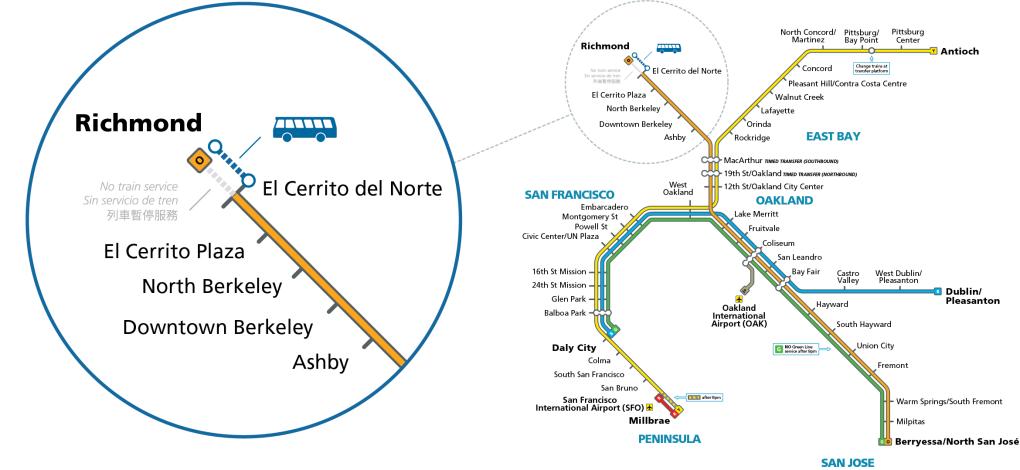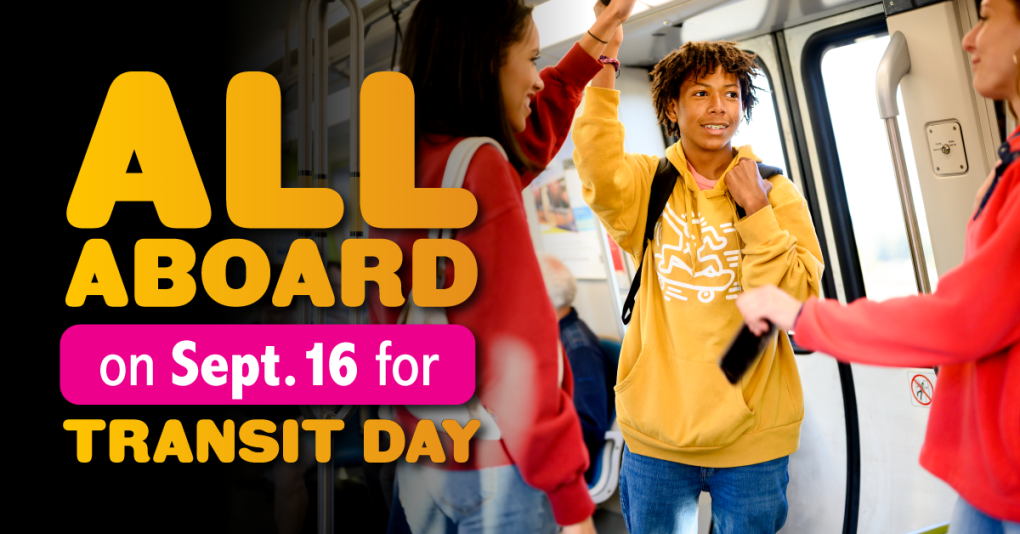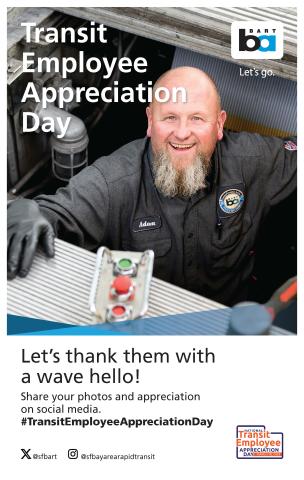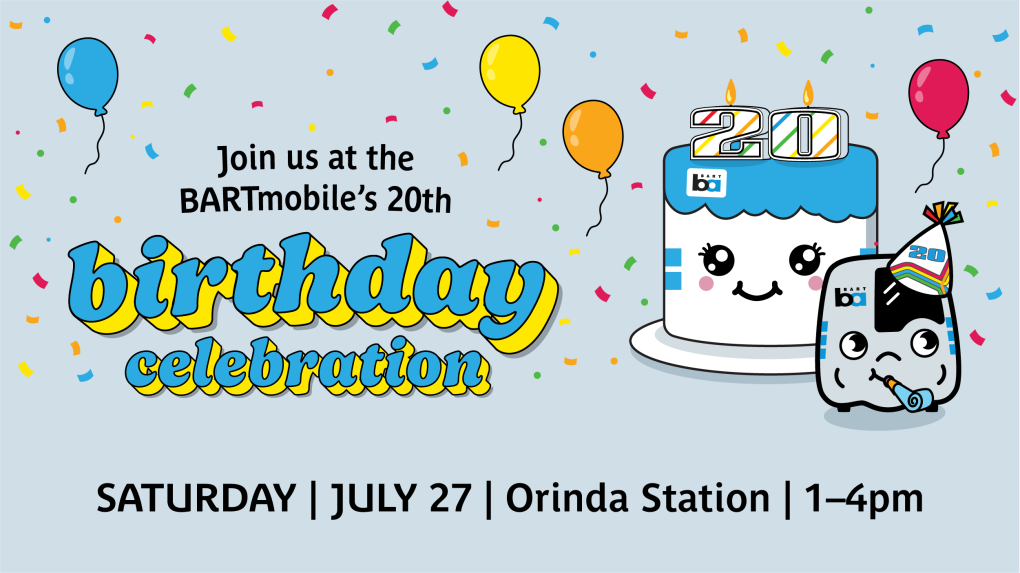Search Results
Bus Bridge and Red Line Cancellation Alert: Major trackway rebuilding work near Richmond Station on four non-consecutive weekends
Update 4/15/24: The final bus bridge that had been scheduled between Richmond and El Cerrito del Norte the weekend of April 27-28 has been cancelled. Instead, our team will do trackway replacement work on the Yellow Line between Rockridge and Lafayette stations the weekend of 4/27-28. Get more details on this project here: https://www.bart.gov/news/articles/2024/news20240313
BART’s next major track improvement project will focus on replacing track equipment near Richmond Station. On four non-consecutive weekends in February, March, and April workers will replace an interlocking near Richmond Station. Interlockings allow BART to safely move trains from line to line and are an essential part of the system. Work will also be done to address vegetation that could impact service.
The weekend dates for this project are February 17-19 (Presidents’ Day Weekend), 3/16-17, 4/13-14, and 4/27-28.
- Free buses will replace train service between Richmond and El Cerrito del Norte stations on all four weekends.
- The Red Line (Richmond-Millbrae) will be cancelled thus reducing service frequency and transbay options during these weekends. Transbay riders in the East Bay who would normally take the Red Line should instead board an Orange Line (Richmond-Berryessa) train and transfer to a Yellow Line train to San Francisco at MacArthur Station. This is scheduled to be a timed transfer to reduce wait times.
- Millbrae riders will be served by a shuttle train between SFO and Millbrae that is timed with the Yellow line train for an easy transfer at SFO.
- Riders can expect delays of up to 20 minutes in the work area on shutdown weekends.
- Richmond Station will not have train service but will still be open for Amtrak passengers and passengers traveling through the station. Riders will be able to board the bus bridge at Richmond.
Cyclists might find it faster to ride their bike along Nevin Ave in Richmond and the Ohlone Greenway to avoid the bus bridge and reduced frequency on the Richmond line.
You can keep up with the latest updates for trackway repair projects that impact service by going to our Alerts and Advisories page. BART’s Trip Planner has been improved to show the full customer journey including bus bridges.
BART wants to thank AC Transit for providing buses for BART riders during this track closure. Bay Area transit agencies are improving regional coordination to keep the Bay Area moving.
The equipment being replaced is decades old and has outlived its design life. Riders will enjoy a smoother, safer, more reliable, and quieter ride once the projects are complete.
This upcoming work is part of BART’s overall effort to improve the safety and reliability of the 131-mile, 50 station system. You can learn more about the progress of this work by reading the 2023 Measure RR Annual Report published by the independent Measure RR Bond Oversight Committee.
This article was originally posted on January 22, 2024.

Millbrae parking garage to expand Reserved Area to accommodate anticipated holiday demand
The Millbrae parking garage will be reconfigured over the next few weeks to accommodate for more reserved parking and the growing demand for single/multi-day reserved parking. The top floor of the garage and a portion of the 4th floor will be converted from Daily Fee to Reserved parking in preparation for the holiday season.
Millbrae is a popular and convenient station for BART riders to park and access the San Francisco International Airport, just a quick 4-minute BART ride away. This change supports customers purchasing single/multi-day reserved parking when they are headed to the airport. Customers may purchase single/multi-day reserved parking at Millbrae on the BART Official App or on BART’s website.
There is still ample parking for Daily Fee parking on the first three floors of the garage. In the next few months, additional Daily Fee parking will become available at the nearby surface parking lot.
Strategic Framework and Action Plans
Saturday Sept. 16 is All Aboard Transit Day; Let's beat the ridership record

Sept 22 Update:
In celebration of Transit Month the Bay Area transit agencies and the MTC hosted All Aboard Transit Day last Saturday, September 16th.
We challenged the region to break the Saturday September 2022 ridership record of 500,000+ trips across all modes of transit.
We are thrilled to announce, riders came together across the Bay Area and took a stupendous 600,000+ trips across all local transit agencies!
Thank you for taking transit and let's continue to momentum this weekend!
On Saturday, September 16, 2023, take as many transit trips your heart desires and help us beat the Saturday September 2022 ridership record!
All Aboard Transit Day is in celebration of Transit Month and to encourage the Bay Area to try transit.
We will add up the total ridership for the day and report out to the public and news media if we exceeded the Saturday, September 17, 2022 ridership, which was the highest ridership of a Saturday in September during Transit Month 2022.
On September 16, 2023, BART will also host "Meet the BART Anime Mascots" event at Powell Street Station from 2pm to 6pm. Take photos with the mascots, make buttons with staff, grab a prize from the BART capsule ball machine, and more! Come in cosplay and get a rare BART anime charm. The Link21 outreach team will also be there to talk about our project to build a second train crossing connecting Oakland and San Francisco.
BART will also have special late-night service for the Ed Sheeran concert at Levi’s Stadium on Saturday, September 16, 2023.
Parking rate changes at North Concord and South Hayward stations effective Sept 1, 2023
Effective September 1, 2023, parking fees at North Concord and South Hayward stations will be changing. All transactions made on or after September 1 will reflect the new prices shown in the table below. Any reservations (Single/Multi-Day or Monthly Reserved) made before September 1, 2023, regardless of reservation dates, will reflect the price at time of purchase. Current monthly parking holders’ reservations will be renewed on September 15 for October and will be charged the new lower price.
| Daily Fee (Per day) | Single/Multi-Day Reserved (Per day) | Monthly Reserved (Per month) | ||||
|---|---|---|---|---|---|---|
| Station | Current | New | Current | New | Current | New |
| North Concord/Martinez | $2.50 | $3.00 | $5.50 | $4.00 | $94.50 | $84.00 |
| South Hayward | $2.00 | $3.00 | $5.00 | $4.00 | $84.00 | $84.00 |
Parking prices are being updated to create a consistent price floor of $3/day (plus any applicable taxes) at all stations per recently approved policy by the BART Board of Directors. Prices may increase above this floor if lots begin to fill up. For details on how rate adjustments are made, see BART’s Parking Pricing Policy.
BART offers discounted fares to qualifying low-income riders. Please visit clipperstartcard.com to learn more. Parking discounts/commuter benefits may also be available through your employer.
Pay for parking on the official BART app or at machines inside stations with debit, credit, or cash.
Questions? Visit BART’s Parking Overview Page or our FAQs.
Today is National Transit Employee Appreciation Day!
Image
Today, March 18, is one of our favorite days of the year around BART – National Transit Employee Appreciation Day!
National Transit Employee Appreciation Day is an annual celebration of the millions of transit employees who keep us all on the move, and on this day, BART invites members of the public to express their gratitude to our hardworking employees.
If you see a BART employee while you’re traveling around the system today, give them a wave and a smile or a “Hello!” and “Thank you!” We also invite you to share your photos and messages of appreciation on social media -- tag them with #TransitEmployeeAppreciationDay. Our employees appreciate knowing you appreciate them.
You should also keep your eyes out for employee recognitions around stations, including posters highlighting some of the faces of our stellar staff. Keep your ears open, too; announcements recorded by some very special guests will be playing on the station speakers.
BART will be celebrating our employees internally this week as well. If you’re a BART employee reading this, you have received or will be receiving an acknowledgement with some tokens of appreciation in the mail.
We can't express enough gratitude to our employees, who are working hard every day to provide high-quality train service to our customers. Speaking of, in the last quarter, we have elevated our overall customer satisfaction rating to 81%, an increase of 7% from the previous quarter. This is the first time since 2012 that our customer satisfaction rating has broken the 80s! We have our employees to thank for that.
Happy National Transit Appreciation Day!

It’s a BARTy party! Join us on Saturday, July 27, for the BARTmobile’s 20th Birthday Party

Mark your calendars! On Saturday, July 27, BART invites the public to Orinda Station for the BARTmobile’s 20th Birthday Party.
For two decades, the BARTmobile has been a fixture at local events and parades. By hosting a birthday party, we want to honor its place in regional history and have an excuse to gather in a station to celebrate public transportation with our Bay Area community.
Always wanted to ride in the BARTmobile? Here’s your chance! We’ll be giving members of the public free rides throughout the event.
In addition to rides, you can also expect:
- Live DJ
- Railgoods.com pop-up shop (holiday merch cannot be preordered at the event, only online)
- Carnival games
- Face painting + temporary tattoos
- Free cupcakes and kettle corn (we recommend eating lunch beforehand as no food will be sold)
- Free BARTy stickers
- Stamps for your BART Stamp Passport
- And more family-friendly activities!
The BARTmobile has quite a fun origin story, so we encourage you to brush up on your BARTy history by reading our article all about BART’s unique mascot – click here.
This event is part of BART’s engagement strategy to activate stations and encourage the public to ride our trains by showing off the many recent improvements we’ve made to the system, including doubling the safety staff presence on trains as well as the number of train and station cleanings.
BART will be hosting more events throughout the year, including this summer’s Sound Tracks – free live music by local artists in the non-paid areas of stations.
Temporary Station Closure Alert: Pittsburg Center to be closed March 8-9 for installation of Next Generation Fare Gates
Pittsburg Center Station will be closed on Saturday, March 8 and Sunday, March 9 to allow work crews to install Next Generation Fare Gates at the station. Pittsburg Center must be closed to facilitate this work because it’s typically unstaffed and is smaller compared with typical BART stations. During the temporary station closure, Yellow Line service will continue to run between Pittsburg/Bay Point and Antioch stations. Trains will run through Pittsburg Center without making stops at that station. Additionally, eBART will operate on a new schedule. Trains from Antioch will depart earlier and arrive later than their published departure times to accommodate work on the Pittsburg Center platforms.
Riders who typically use Pittsburg Center are advised to instead use Antioch or Pittsburg/Bay Point stations during the temporary closure. A free shuttle will replace train service between Pittsburg Center and Pittsburg/Bay Point. The free shuttle will take about 10 minutes to travel between stations and will depart every 20 minutes. Riders who still need to get to or from Pittsburg Center can take the free shuttle provided by Tri Delta Transit. Antioch riders who need to get to Pittsburg Center should take BART from Antioch to Pittsburg/Bay Point and then take a free shuttle bus back to Pittsburg Center.
The latest work comes after BART has successfully installed Next Generation Fare Gates at 18 other stations across the system. All 50 BART stations will have new fare gates by the end of 2025. You can learn more about BART’s Next Generation Fare Gate project here.
Normal train service has resumed between Richmond and MacArthur Station
(Updated 9am, May 14, 2024)
On Friday, May 10, 2024, a damaged, 20-year-old fiber optic cable was located just north of MacArthur Station late at night before the end of service. The damaged cable was impacting all communication necessary to run train service on the entire line. It was also impacting all station-level communication including the public address systems, phones, and message boards at all stations from Richmond to Ashby. Crews determined the degraded cable was not stable enough for a quick repair.
At 4:48am, the first BART Service Advisory was released alerting the public there would be no Red Line service and the Orange Line would not run between Richmond and MacArthur. Orange Line service was provided from MacArthur to Berryessa and Millbrae service was provided by a shuttle train between Millbrae and SFO. The Yellow, Blue, and Green lines were not impacted.
Partner bus agencies and Capitol Corridor honored BART fares. Extra BART employees were deployed to stations to help guide riders to the various bus options. Given how many stations were impacted, AC Transit was unable to provide a bus bridge with direct service to MacArthur Station. However, Richmond Line stations have high quality transbay and local bus route options and BART riders were able to ride them at no cost. A list of each bus option was posted on the home page of bart.gov and shared on social media.
Crews worked with BART’s fiber contractors to successfully splice BART’s 48-strand fiber optic cable to redundantly located fiber optic cable allowing for service to resume at 11:10am. This solution will remain in place long term.
As of 11:10am, we have restored normal train service between Richmond and MacArthur. We will follow up with more details about the cause of the disruption on Monday.
In an effort to improve communication during disruptions we are asking impacted riders to take this short survey before Monday, May 13th, at 5pm:
bart.gov/delays
We currently have no Red or Orange line service between Richmond and MacArthur due to a wayside equipment problem. Crews are on scene and are trouble shooting the problem. We hope to have this resolved shortly but expect this service disruption to last through the morning commute. The Yellow, Green and Blue lines are not impacted, and we do have normal service throughout the rest of the system.
Richmond riders should seek other means to get to MacArthur Station. Richmond through Ashby station riders should use the existing bus service at each station. For Millbrae riders, take the shuttle train between SFO and Millbrae and transfer to/from the Yellow line (Antioch-SFO). Orange line service is running MacArthur to Berryessa.
While we do have extra staff at each station to help with buses, there isn’t a direct bus bridge. We do have mutual aid from Capitol Corridor and various bus agencies that varies from Station to Station.
Capitol Corridor will offer free rides to BART passengers only between Richmond and Oakland Coliseum until 3PM.
BUSES TO DOWNTOWN SAN FRANCISCO
Richmond Station
- 72M to NL (AC Transit)
- Transfer from 72M to NL at 20th/Broadway in Oakland
- Takes 1 hour and 25 minutes
El Cerrito del Norte
- 72/72M to NL (AC Transit)
- Transfer from 72M to NL at 20th/Broadway in Oakland
- Takes 1 hour and 7 minutes
- L (AC Transit)
- Takes 48 minutes
- 72/72M/72R to G (AC Transit)
- Transfer at San Pablo and Gilman
- 48 minutes
- 72/72M to F (AC Transit)
- Transfer at San Pablo and 40th
- 53 minutes
El Cerrito Plaza
- G (AC Transit)
- 54 minutes
- L (AC Transit)
- Walk from station to San Pablo and Central
- 42 minutes
- 72/72M to NL (AC Transit)
- Transfer from 72M to NL at 20th/Broadway in Oakland
- Takes 55 minutes
- 72/72M to F (AC Transit)
- Transfer at San Pablo and 40th
- 51 minutes
North Berkeley
- J (AC Transit)
- Walk to Sacramento and University
- Takes 48 minutes
- G (AC Transit)
- Walk to San Pablo and Delaware
- Takes 41 minutes
o Casual Carpool: https://sfcasualcarpool.com/
Downtown Berkeley
- F (AC Transit)
- Takes 41 minutes
Ashby
- F (AC Transit)
- Takes 37 minutes
LOCAL OPTIONS for travel between stations.
Richmond Station – El Cerrito del Norte – El Cerrito Plaza
- AC Transit 72/72M
North Berkeley – Downtown Berkeley
- AC Transit 52
MacArthur – Ashby – Downtown Berkeley
- AC Transit 6
- AC Transit 18
Downtown Berkeley – Rockridge
- AC Transit 51B
- AC Transit 79
Join Link21 at educational events to learn more about train options for a future crossing between Oakland and San Francisco
Link21 continues to invest in a more connected, equitable, and accessible future by working toward the goal of linking the San Francisco Bay Area Regional Transit (BART) and Regional Rail network throughout 21 counties – referred to as the “Megaregion” – in Northern California.
This past summer, community members from the Megaregion participated in a variety of virtual and in-person engagement events to discuss Link21 concepts and potential service improvements. Now this fall, Link21 is offering community members the opportunity to learn more about the type of train service, BART or Regional Rail, that would operate in the future train crossing between Oakland and San Francisco. Attendees will learn how these two options benefit riders, communities, and the Megaregion, plus how they differ. They will also have the chance to provide input to help the Link21 Program Team identify a recommendation for consideration of a Preliminary Project to be advanced by the BART and Capitol Corridor Boards of Directors in early 2024.
“The feedback we receive from people across our Northern California Megaregion will help us meet the needs of our diverse communities,” said Sadie Graham, Link21 Program Director for BART. “We can’t do this alone and need the public to continue being part of the planning process at every step of this generational undertaking.”
JOIN THE CONVERSATION!
Virtual Events
Participate in a virtual event or look for Link21 in your community to learn more and help connect Northern California with better train service for future generations. Visit the Link21 Events webpage for more details.
Online Open House
Starting in early November and lasting approximately 30 days, you can conveniently visit Link21OpenHouse.com anytime, 24 hours a day, seven days a week to learn more and provide input.
ABOUT LINK21
Link21 is a long-range transportation program sponsored by BART and Capitol Corridor to transform the train network serving the 21-county Northern California Megaregion, which includes the greater San Francisco Bay Area, the Monterey Bay area, the Sacramento area, and the Northern San Joaquin Valley.
Link21 will make it more convenient for people to take BART and Regional Rail (commuter, intercity, and high speed) throughout the Megaregion.
Learn more at Link21Program.org.